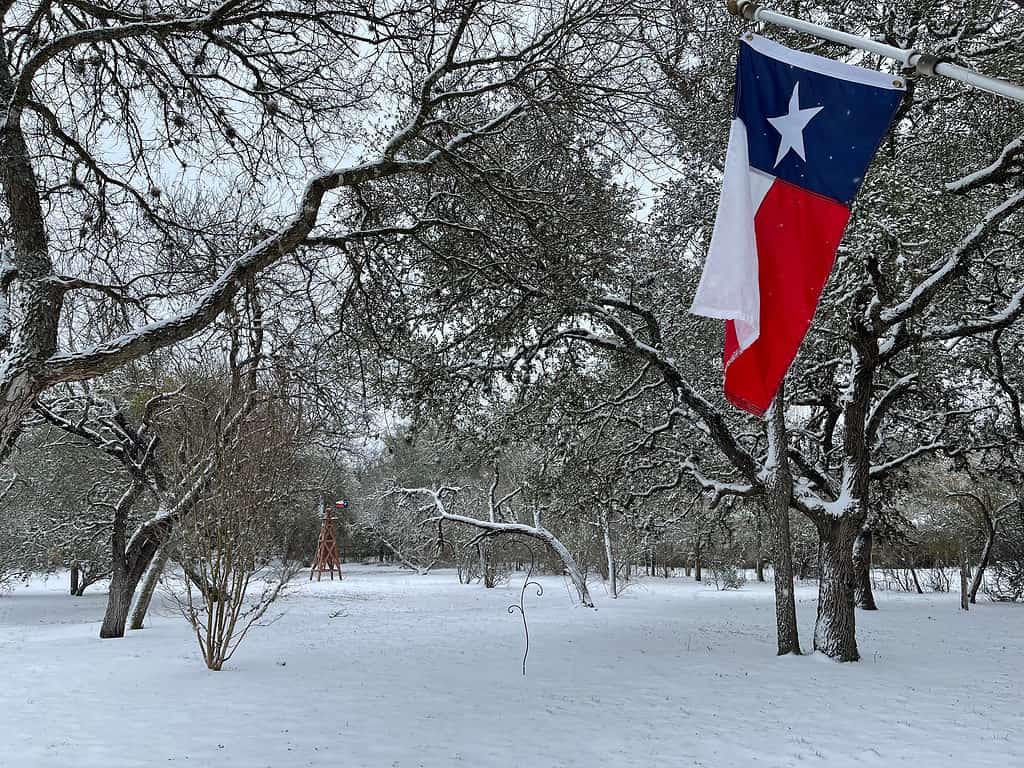Have you ever wondered whether it snows in Texas? After all, this state is rather well known for being hot and dry, or near the coast rather hot and steamy. The answer is simple, and yet complicated by factors such as elevation, proximity to the Gulf of Mexico, and more. Yes, it snows in Texas. In fact, Texas got enough ice and snow in February 2021 that the power grid failed and 246 people actually died. Let’s take a closer look at snowfall trends in Texas and learn more.
The Snowiest Part of Texas

Some parts of Texas, including the panhandle region, receive much more snow than others.
©Lea Bouknight/Shutterstock.com
The panhandle region of Texas gets the most snow on average each year. Snow sometimes comes as early as September in the panhandle, and sometimes falls as late as May. The average amount of snow in the Texas panhandle ranges from about 9 inches per year to around 21 inches, with the eastern portion, at lower elevations, receiving the least. It can also get extremely cold in the panhandle, with record temperatures dropping more than 50 degrees below freezing. Amarillo, the largest city in the Texas panhandle, receives an average of 17.9 inches of snow each year.
Houston Rarely Gets Snow
Meteorologists can count the number of times it has snowed in Houston, Texas. Since 1881, the white stuff has reached the ground fewer than 100 times. Most years, Houston gets no snow, and when they have had snow, it has often amounted to only a trace. That makes 1895 a real outlier. On Valentine’s Day that year, Houston received a whopping 20 inches of snow! No other snowfall has topped 4.4 inches.
Dallas Snowfall Varies Widely
According to the National Weather Service, the Dallas area has received an average of 2.32 inches of snow each winter since the turn of the century. But if you remove the outlier of 17.1 inches in the winter of 2009 to 2010, the yearly average snowfall around Dallas is just 1.65 inches. Most years since 1898, the amount of snow in Dallas has measured between a trace and 5 inches. Annual snow in this part of Texas has exceeded 5 inches fewer than 20 times since the National Weather Service started tracking, and it has exceeded 10 inches only five times.
Snow in Other Texas Cities

Even cities like San Antonio, that rarely get snow, sometimes see more than a trace.
©charlzalan/Shutterstock.com
Advisors at Texas Tech advise incoming students that average snowfall in the Lubbock, Texas region can reach up to 9 inches.
Austin, home of the University of Texas, averages just 0.2 inches of snow per year. The largest snowfall recorded in Austin happened in 1937, when 11 inches fell over two days in November.
The National Weather Service data for Waco, home of Baylor University, indicates that since the year 2000, the area has averaged only 1 inch of snow per year. In about half of the years since the turn of the century, Waco has received 0.1 inches or less.
San Antonio, meanwhile, gets practically no snow, averaging only about 0.1 inches per year even with significant outliers.
Monthly Snow Amounts in Texas

Snowfall amounts in Texas vary according to the region.
©Pi-Lens/Shutterstock.com
Snow amounts vary across Texas, but generally speaking, most of the state’s snowfall occurs in the months of December through February. Snow comes earlier in the western portion of the state and the panhandle than in the eastern and southern sections. This is largely due to higher elevations and proximity to weather systems that approach from the northwest.
Looking at data from the Dallas/Fort Worth region, roughly in the middle of the expansive state, snow rarely comes in October, and then only in trace amounts. With the exception of a few odd occurrences, November likewise barely gets even a trace of snow. The area seldom gets more than a trace of snow in December, but when it does, the amount often reaches 1.5 to 3 inches. Most years central Texas gets at least a trace of snow in January, with some years reaching 3.5 to 12 .1 inches. February returns to mostly trace amounts, but with some years seeing significant outliers and heavy snow events. Central Texas rarely sees snow in March, and almost never in April.
Snowfall Summary

Winter storm Uri in February 2021 covered much of Texas in ice and snow.
©iStock.com/RoschetzkyIstockPhoto
The chances of snow in the southern and eastern parts of Texas are pretty rare every month. Anything more than a trace tends to be an outlier in those regions. The table below summarizes the chances of snow, based on data from the central, western, and panhandle regions of the Lone Star State.
| Month | Chances of Snow |
|---|---|
| September | Extremely rare outside the panhandle |
| October | Small amounts in the west and panhandle; rare otherwise |
| November | Rarely more than trace amounts except in the west and panhandle |
| December | At least trace amounts likely in central region; more in the west and panhandle |
| January | At least trace amounts through central region; some years feature heavier events |
| February | Central region mostly trace amounts with heavy events some years; more in the west |
| March | Rare in central region; small amounts still likely in the wet and panhandle |
| April | Almost never in central region; somewhat rare in the west and panhandle |
| May | Rare in the panhandle region |
The photo featured at the top of this post is © Lea Bouknight/Shutterstock.com
